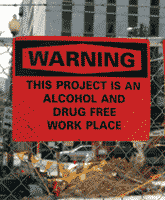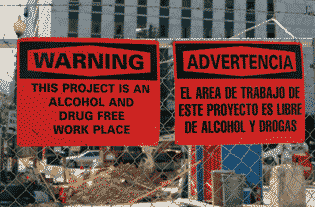
Drugs and Alcohol Workplace Trends
More employers are screening all applicants for all positions to minimize discrimination liability.
- By Mindy Chapman
- Aug 08, 2007
 Q: What are the current statistics regarding workplace impairment?
Q: What are the current statistics regarding workplace impairment?
A: The trends between alcohol and drug use in the workplace are interesting. According to a recent study funded by the National Institute on Alcohol Abuse and Alcoholism, about 15 percent of U.S. workers, or 19.2 million workers, are under the influence of alcohol at least occasionally while on the job. Managers are more likely impaired on the job than are their reports. Workplace alcohol use is more prevalent with men than women, younger workers than older ones, unmarried than married, and more use by employees working on the evening shift, night shift, and irregular shifts.
High rates of alcohol use and impairment have been found in many occupations, including sales, sports, entertainment, media, food preparation and serving, arts, and building and grounds maintenance. In contrast, according to The Drug Testing Index, workplace drug use hit a new low last year. There was a decline in positive drug test results for amphetamines among safety-sensitive workers, along with a decrease in positive marijuana drug test results among the general U.S. workforce.
Q: What are the trends in workplace testing for drugs and alcohol?
A: The four types of testing remain strong. "Pre-employment Substance Testing" is used to screen all applicants for particular positions or all positions. The trend is to screen all applicants for all positions to minimize discrimination liability. "Random Substance Testing" is testing of employees on an irregular, unannounced schedule and is a critical feature of organizations committed to a substance-free workplace. The trend is to use a random-number-generating computer to select employees, rather than a human decision-making process, in order to avoid claims of discrimination.
"Scheduled Annual or Semi-Annual Substance Testing" is best used when it is part of an ongoing rehabilitation process. Tests of this type are less effective when used as a sole means for testing for substances because employees know about the test and can abstain prior to the tests. "For Cause-Reasonable Suspicion Substance Testing" is used when employees are suspected of substance abuse on the job because they have behaved erratically, smelled of alcohol, or were the subject of complaints from the public, customers, or fellow employees. Of course, employers can substance test after any work-related accident.
Q: What are the risks today with substance abuse testing?
A: The current most common legal claims against employers by applicants and employees are in the areas of negligent intentional/unintentional infliction of emotional distress, violations of public policy statutes, violations of civil rights due to unreasonable search and seizure, discrimination, and invasion of privacy. These claims can be minimized with solid policies and procedures that are adhered to consistently and fairly throughout the organization. The key is compliance to using the programs in an ethical and non-discriminatory manner.
Q: Do the benefits outweigh the risks described above?
A: Yes, the positive rewards of substance abuse testing programs far outweigh the negative risks. Fair and impartial substance testing programs provide numerous advantageous to organizations, including increased workplace safety, reduced accidents, greater productivity, increased morale, and less litigation. Other positive impacts include decreases in substance abuse absences, employee theft, workplace violence, and employee conflict.
All of these rewards for maintaining a fair and impartial substance abuse program create substantial cost savings to the bottom line.
Q: What should a solid substance abuse policy address?
A: There are many key parts to an effective and successful Drug and Alcohol Policy. An organization should clearly state its "objective," such as, "This policy establishes guidelines and procedures to provide a safe workplace free from drugs, alcohol, and contraband in order to provide a secure workplace for employees and those doing business with us." The "Scope of the Policy" needs to address whom the policy applies to, as well as which physical locations. The "Procedures" section should outline what is strictly prohibited by the policy. The "Testing Program" needs to define the procedures for all testing programs, as well as how notice will be given.
Remember to include a "Search of Company Premises" section regarding the employer's right to conduct searches of all covered premises at any time and the employee's requirement to cooperate with the searches. Make sure the "Disciplinary Action" section details the consequences for policy violations.
It is a good practice to have a "Definitions" section to explain various terminologies within the policy. Lastly, a "General Section" should be considered to address miscellaneous issues, such as how federal, state, or local laws (or rules or regulations) may limit the policy, and the impact of such a limitation. Remember, policies are legal documents, and it is always a best practice to work with competent legal counsel to prepare and execute sound policies and procedures.
Q: What advice do you have for employers who want to start a substance abuse testing program in 2007 or 2008?
A: Employers looking to introduce a substance abuse testing program should plan on a fair notice period prior to initiating any series of testing. This period will give employees with substance abuse problems time to seek rehabilitation. Additionally, employers with collective bargaining agreements need to know that drug testing is a mandatory subject of bargaining. Therefore, introducing a testing program during a contract period is problematic, and they may be charged with making unlawful changes to their collective bargaining agreement.
An effective substance abuse testing program is comprised of many critical components, which include a solid written policy and set of procedures; fair, consistent, and ethical administration; trained supervisors; and a reliable, impartial substance abuse laboratory.
Disclaimer: This material is provided as general information and is not a substitute for legal or other professional advice. © Copyright 2007. Mindy H. Chapman LLC. All rights reserved.
This article originally appeared in the August 2007 issue of Occupational Health & Safety.